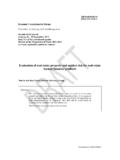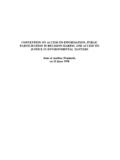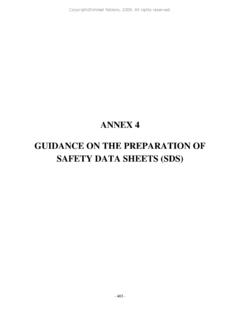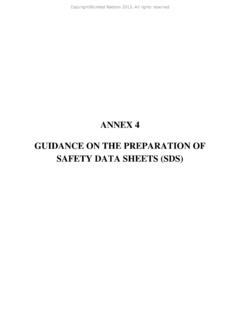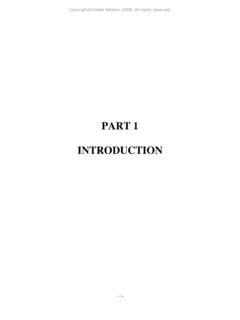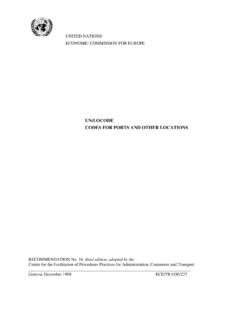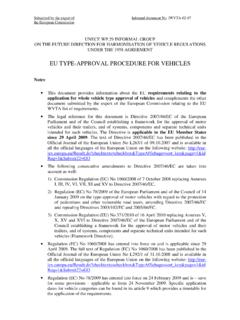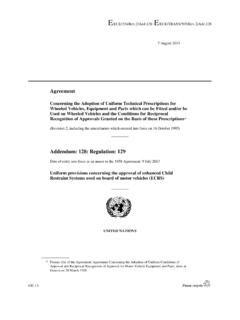Transcription of PART 3 Dangerous goods list, special provisions …
1 - 279 - PART 3 Dangerous goods list, special provisions and exemptions related to limited and excepted quantities Copyright United Nations, 2010. All rights reservedCopyright United Nations, 2010. All rights reserved- 281 - CHAPTER GENERAL Introduction In addition to the provisions referred to or given in the tables of this Part, the general requirements of each Part, Chapter and/or Section are to be observed. These general requirements are not given in the tables.
2 When a general requirement is contradictory to a special provision, the special provision prevails. Proper shipping name NOTE: For proper shipping names used for the carriage of samples, see The proper shipping name is that portion of the entry most accurately describing the goods in Table A in Chapter , which is shown in upper case characters (plus any numbers, Greek letters, "sec", "tert", and the letters "m", "n", "o", "p", which form an integral part of the name).
3 An alternative proper shipping name may be shown in brackets following the main proper shipping name [ , ETHANOL (ETHYL ALCOHOL)]. Portions of an entry appearing in lower case need not be considered as part of the proper shipping name. When conjuncti ons such as "and" or "or" are in lower case or when segments of the name are punctuated by commas, the entire name of the entry need not necessarily be shown in the transport document or package markings.
4 This is the case particularly when a combination of several distinct entries are listed under a single UN Number. Examples illustrating the selection of the proper shipping name for such entries are: (a) UN 1057 LIGHTERS or LIGHTER REFILLS - The proper shipping name is the most appropriate of the following possible combinations: LIGHTERS LIGHTER REFILLS.
5 (b) UN 2793 FERROUS METAL BORINGS, SHAVINGS, TURNINGS or CUTTINGS in a form liable to self-heating. The proper shipping name is the most appropriate of the following combinations: FERROUS METAL BORINGS FERROUS METAL SHAVINGS FERROUS METAL TURNINGS FERROUS METAL CUTTINGS. Proper shipping names may be used in the singular or plural as appropriate.
6 In addition, when qualifying words are used as part of the proper shipping name, their sequence on documentation or package markings is optional. For instance, "DIMETHYLAMINE AQUEOUS SOLUTION" may alternatively be shown "AQUEOUS SOLUTION OF DIMETHYLAMINE". Commercial or military names for goods of Class 1 which contain the proper shipping name supplemented by additional descriptive text may be used. Copyright United Nations, 2010. All rights reserved- 282 - Many substances have an entry for both the liquid and solid state (see definitions for liquid and solid in ), or for the solid and solution.
7 These are allocated separate UN numbers which are not necessarily adjacent to each other 1. Unless it is already included in capital letters in the name indicated in Table A in Chapter , the qualifying word "MOLTEN" shall be added as part of the proper shipping name when a substance, which is a solid in accordance with the definition in , is offered for carriage in the molten state ( ALKYLPHENOL, SOLID, , MOLTEN). Except for self-reactive substances and organic peroxides and unless it is already included in capital letters in the name indicated in Column (2) of Table A of Chapter , the word "STABILIZED" shall be added as part of the proper shipping name of a substance which without stabilization would be forbidden from carriage in accordance with paragraphs due to it being liable to dangerously react under conditions normally encountered in carriage (.)
8 "TOXIC LIQUID, ORGANIC, , STABILIZED"). When temperature control is used to stabilize such substances to prevent the development of any Dangerous excess pressure, then: (a) For liquids: where the SADT is less than or equal to 50 C, the provisions of , the special provision V8 of Chapter , the special provision S4 of Chapter and the requirements of Chapter shall apply; for carriage in IBCs and tanks, all the provisions applicable to UN No. 3239 apply (see in particular , packing instruction IBC520 et ); (b) For gases: the conditions of carriage shall be approved by the competent authority.
9 Hydrates may be carried under the proper shipping name for the anhydrous substance. Generic or "not otherwise specified" ( ) names Generic and "not otherwise specified" proper shipping names that are assigned to special provision 274 or 318 in Column (6) of Table A in Chapter shall be supplemented with the technical name of the goods unless a national law or international convention prohibits its disclosure if it is a controlled substance. For explosives of Class 1, the Dangerous goods description may be supplemented by additional descriptive text to indicate commercial or military names.
10 Technical names shall be entered in brackets immediately following the proper shipping name. An appropriate modifier, such as "contains" or "containing" or other qualifying words such as "mixture", "solution", etc. and the percentage of the technical constituent may also be used. For example: "UN 1993 FLAMMABLE LIQUID, (CONTAINS XYLENE AND BENZENE), 3, II". The technical name shall be a recognized chemical name or biological name, or other name currently used in scientific and technical handbooks, journals and texts.

